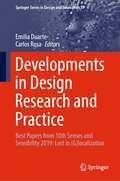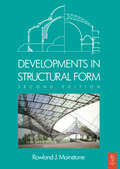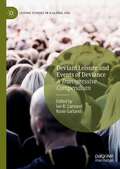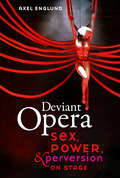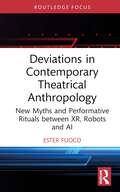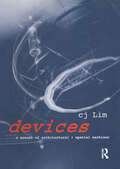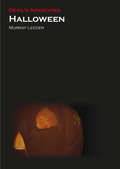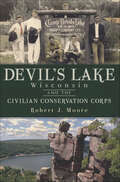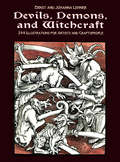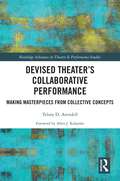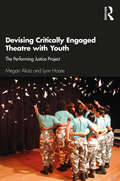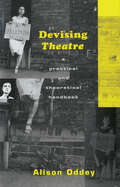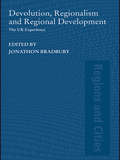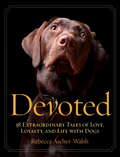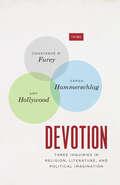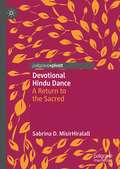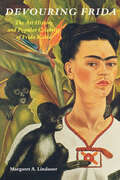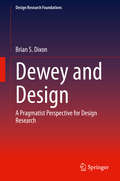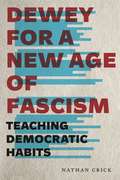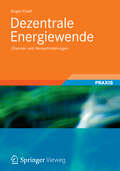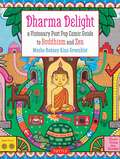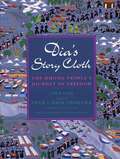- Table View
- List View
Developments in Design Research and Practice: Best Papers from 10th Senses and Sensibility 2019: Lost in (G)localization (Springer Series in Design and Innovation #17)
by Emilia Duarte Carlos RosaThis book reports on innovative research and practices in contemporary design, showing how to integrate different concepts and discussing the emerging role of design in different field, its meaning for humans and citizens, at both local and global level. Gathering the best papers from Senses & Sensibility, held in 2019 in Lisbon, Portugal, it highlights the role of design in fostering education, physical and social wellbeing, industrial innovation and cultural preservation, as well as inclusivity, sustainability and communication in a global, digital world.
Developments in Structural Form
by Rowland MainstoneIn the critically acclaimed first edition of this book, Mainstone offered a brilliant and highly original account of the structural developments that have made possible the achievements of architects and bridge builders throughout history.In this extensively revised and expanded new edition, now available in paperback, new insights and a full coverage of recent developments in both design and construction are incorporated. The book identifies features that distinguish the forms built by man from those shaped by nature and discusses the physical and other constraints on the choices that can be made. It then looks in turn at all the elementary forms - arches, domes, beams, slabs and the like - which combine into the more complex forms of complete structures, and at the different classes of the complete forms themselves. The development of each form is traced chronologically, but with an emphasis less on the chronology than on the problems that designers have continually faced in trying to serve new ends with limited means or to serve old ones in new ways. The book concludes with a chapter on the processes of design, showing how the designer's freedom of choice has been widened by a growing understanding of structural behaviour.
Deviant Leisure and Events of Deviance: A Transgressive Compendium (Leisure Studies in a Global Era)
by Ian R. Lamond Rosie GarlandThis volume is the first to draw together theoretical reflection, empirical research, and critical reflection on practice occurring at the juncture of critical approaches in leisure studies and event studies within diverse explorations of deviance. It includes chapters on games and gaming; performing queerness; events around being kinkster; drugs and sex, LGBTQ+ events and activism, and goth subculture. These are combined with poetry, personal reflection and artwork, much of which has been created by contributors. The compendium draws on inquiry undertaken by contributors from a wide spectrum of academic disciplines, as well as deviant leisure practitioners/event organisers. It seeks to expand the cultural and academic articulation of deviance into other disciplines and to develop new perspectives on deviant leisure and deviant leisure practice. It speaks to students, researchers, and practitioners working or interested in critical leisure and event studies, queer theory, cultural theory, burlesque/circus studies, media studies, and discourse studies.
Deviant Opera: Sex, Power, and Perversion on Stage
by Axel EnglundImagine Armida, Handel’s Saracen sorceress, performing her breakneck coloraturas in a black figure-hugging rubber dress, beating her insubordinate furies into submission with a cane, suspending a captive Rinaldo in chains from the ceiling of her dungeon. Mozart’s peasant girl Zerlina, meanwhile, is tying up and blindfolding her fiancé to seduce him out of his jealousy of Don Giovanni. And how about Wagner’s wizard, Klingsor, ensnaring his choir of flower maidens in elaborate Japanese rope bondage? Opera, it would appear, has developed a taste for sadomasochism. For decades now, radical stage directors have repeatedly dressed canonical operas—from Handel and Mozart to Wagner and Puccini, and beyond—in whips, chains, leather, and other regalia of SM and fetishism. Deviant Opera seeks to understand this phenomenon, approaching the contemporary visual code of perversion as a lens through which opera focuses and scrutinizes its own configurations of sex, gender, power, and violence. The emerging image is that of an art form that habitually plays with an eroticization of cruelty and humiliation, inviting its devotees to take sensual pleasure in the suffering of others. Ultimately, Deviant Opera argues that this species of opera fantasizes about breaking the boundaries of its own role-playing, and pushing its erotic power exchanges from the enacted to the actual.
Deviations in Contemporary Theatrical Anthropology: New Myths and Performative Rituals between XR, Robots and AI (ISSN)
by Ester FuocoThis book refers to the artistic deviation from dominant goals in a social system or from means considered legitimate in that system.This book explores a "New Humanism" in the performing arts, unique in the sense of human's ability to co-create and communicate beyond spatial and temporal boundaries, wars, and pandemics, through artistic deviations carried out by machines and through the Extended Reality. Through the lens of anthropology and aesthetics, this study selects useful case studies to demonstrate this phenomenon of performative symphonises, in which the experimentation of AI-driven creativity and the new human-robot interaction (HRI) lead to philosophical inquiries about the nature of creativity, intelligence, and the definition of art itself. These shifts in paradigms invite us to reconsider established concepts and explore new perspectives on the relationship between technology, art, and the human experience.This book will be of great interest to students and scholars in theatre and performance studies, anthropology, and digital humanities.
Devices
by cj LimEmbedding memories into landscape. Measuring moisture, pressure and wind speed within a bedroom. Drawing power with a potato. These are but a few of the preoccupations described within this book.‘Devices’ is a manual celebrating the invention of architectural and spatial machines. Nostalgic, metaphorical, analytical or even the down-right daft, each of the illustrated pieces demonstrates the potential for spatial occupation, leading to new territories in architectural design.A detailed analysis of each device and a ‘recipe’ for its construction is provided, including working drawings, assembly diagrams, materials and component descriptions. The reader will not only gain an insight into the technical makeup of the devices, but will have all the information at their fingertips to design and construct ground-breaking innovations of their own. With over 40 devices, this book will inspire architects, designers, engineers and artists alike.
Devil's Advocates: Halloween
by Murray LeederA bold and provocative study of Carpenter's film, which hopes to expose qualities that are sometime effaced by its sequels and remakes
Devil's Lake, Wisconsin and the Civilian Conservation Corps
by Robert J. MooreThousands of young men embarked on the adventure of a lifetime when they joined the Civilian Conservation Corps during the Great Depression.Service at Wisconsin's popular state park offered notoriety absent at most camp assignments. While most of the CCC work around the country was in remote forests and farmlands, at Devil's Lake tourists could view CCC project activity each day, forging that labor into an essential part of the park experience. Historian Robert J. Moore interviews veterans and mines the archives to preserve this legacy so that the gasps of wonder at nature's marvels remain mixed with respect for the men who helped bring them forth.
Devils, Demons, and Witchcraft: 244 Illustrations for Artists
by Ernst Lehner"Throughout history, artists have grappled with the problem of depicting clearly and forcefully the principles of evil and suffering in human existence." With this view, the Lehners have collected 244 representations, symbols, and manuscript pages of devils and death from Egyptian times to 1931. Reproductions from Dürer, Holbein, Cranach, Rembrandt, and many other lesser-known or unknown artists illustrate the fascinating history. The fifteenth, sixteenth, and seventeenth centuries are stressed.The book is divided into 12 chapters, each with a separate introduction. Most of the illustrations are collected in five of these chapters: Devils and Demons, including Belial, Beelzebub, and the Anti-Christ; Witches and Warlocks, their animals, forms, and rituals; The Danse Macabre, with the Dance of Death Alphabet by Holbein and representations of all classes leveled by the common force of death; Memento Mori, including a skull clock, a macabre representation of the Tree of Knowledge and Death, and the winged hourglass and scythe; and Religio-Political Devilry, the fight between the Papists and the Reformers, and symbols of devils in other political disputes. There are also chapters on the Fall of Lucifer, Faust and Mephistopheles, Hell and Damnation, The Apocalyptic Horsemen, Witch-Hunting, The Art of Dying, and Resurrection and Reckoning.Anyone curious about witchcraft, death, and devils will be interested in this book. It is particularly useful to teachers, artists, and illustrators who need clear reproductions for the classroom, for models, or for commercial uses. Death, devils, and their history are very much with us today.
Devised Theater’s Collaborative Performance: Making Masterpieces from Collective Concepts (Routledge Advances in Theatre & Performance Studies)
by Telory D ArendellThis book provides a fascinating and concise history of devised theatre practice. As both a founding member of Philadelphia’s Pig Iron Theater Company and a Professor, Telory Arendell begins this journey with a brief history of Joan Littlewood’s Theatre Workshop and Living Newspapers through Brecht’s Berliner Ensemble and Joe Chaikin’s Open Theatre to the racially inflected commentary of Luis Valdez’s Teatro Campesino and Ariane Mnouchkine’s collaboration with Théâtre de Soleil. This book explores the impact of devised theatre on social practice and analyzes Goat Island’s use of Pina Bausch’s gestural movement, Augusto Boal’s Theatre of the Oppressed in Giving Voice, Anna Deavere Smith’s devised envelope for Verbatim Theatre, The Tectonic Theatre Project’s moment work, Teya Sepinuck’s Theatre of Witness, Pig Iron’s use of Lecoq mime to build complex physical theatre scripts, and The Riot Group’s musical arrangement of collaborative devised text. Included are a foreword by Allen J. Kuharski and three devised plays by Theatre of Witness, Pig Iron, and The Riot Group. Replete with interviews from the initial Pig Iron collaborators on subjects of writing, directing, choreographing, teaching, and developing a pedagogical platform that supports devised theatre.
Devising Critically Engaged Theatre with Youth: The Performing Justice Project
by Megan Alrutz Lynn HoareDevising Critically Engaged Theatre with Youth: The Performing Justice Project offers accessible frameworks for devising original theatre, developing critical understandings of racial and gender justice, and supporting youth to imagine, create, and perform possibilities for a more just and equitable society. Working at the intersections of theory and practice, Alrutz and Hoare present their innovative model for devising critically engaged theatre with novice performers. Sharing why and how the Performing Justice Project (PJP) opens dialogue around challenging and necessary topics already facing young people, the authors bring together critical information about racial and gender justice with new and revised practices from applied theatre, storytelling, theatre, and education for social change. Their curated collection of PJP "performance actions" offers embodied and reflective approaches for building ensemble, devising and performing stories, and exploring and analyzing individual and systemic oppression. This work begins to confront oppressive narratives and disrupt patriarchal systems—including white supremacy, racism, sexism, and homophobia. Devising Critically Engaged Theatre with Youth invites artists, teaching artists, educators, and youth-workers to collaborate bravely with young people to imagine and enact racial and gender justice in their lives and communities. Drawing on examples from PJP residencies in juvenile justice settings, high schools, foster care facilities, and community-based organizations, this book offers flexible and responsive ways for considering experiences of racism and sexism and performing visions of justice. Visit performingjusticeproject.org for additional information and documentation of PJP performances with youth.
Devising Theatre: A Practical and Theoretical Handbook
by Alison OddeyDevising Theatre is a practical handbook that combines a critical analysis of contemporary devised theatre practice with descriptions of selected companies, and suggestions for any group devising theatre from scratch. It is the first book to propose a general theory of devised theatre. After identifying the unique nature of this type of performance, the author examines how devised theatre is perceived by professional practitioners, and provides an historical overview illustrating how it has evolved since the 1960s. Alison Oddey examines the particular working practices and products of a number of professional companies, including a Reminiscence theatre for the elderly and a theatre-in-education group, and offers ideas and exercises for exploration and experimentation.
Devolution, Regionalism and Regional Development: The UK Experience (Regions and Cities)
by Jonathan BradburyDevolution, Regionalism and Regional Development provides an overview and critical perspective on the impact of devolution on regionalism in the UK since 1999, taking a research-based look at issues central to the development of regionalism: politics, governance and planning. This multidisciplinary book is written by academics from the fields of geography, economics, town planning, public policy, management, public administration, politics and sociology with a final chapter by Patrick Le Gales putting the research findings into a theoretical context. This will be an important book for those researching and studying economic and political geography and planning as well as those involved in regional development.
Devoted
by Rebecca Ascher-WalshUnlikely Friendships meets Marley and Me. In this heartwarming gift book, author Rebecca Ascher-Walsh presents a collection of inspiring dog stories and touching photos--dogs who comfort veterans, dogs who learn to surf, dogs who detect cancer, and dogs who save the day: Each one is devoted. These 38 uplifting dog stories showcase the most amazing dog rescues, accomplishments, and abilities that fascinate us and touch our hearts.From the Hardcover edition.
Devotion: Three Inquiries in Religion, Literature, and Political Imagination (TRIOS)
by Amy Hollywood Sarah Hammerschlag Constance M. FureyThree scholars of religion explore literature and the literary as sites of critical transformation. We are living in a time of radical uncertainty, faced with serious political, ecological, economic, epidemiological, and social problems. Scholars of religion Constance M. Furey, Sarah Hammerschlag, and Amy Hollywood come together in this volume with a shared conviction that what and how we read opens new ways of imagining our political futures and our lives. Each essay in this book suggests different ways to characterize the object of devotion and the stance of the devout subject before it. Furey writes about devotion in terms of vivification, energy, and artifice; Hammerschlag in terms of commentary, mimicry, and fetishism; and Hollywood in terms of anarchy, antinomianism, and atopia. They are interested in literature not as providing models for ethical, political, or religious life, but as creating the site in which the possible—and the impossible—transport the reader, enabling new forms of thought, habits of mind, and ways of life. Ranging from German theologian Martin Luther to French-Jewish philosopher Sarah Kofman to American poet Susan Howe, this volume is not just a reflection on forms of devotion and their critical and creative import but also a powerful enactment of devotion itself.
Devotion: Three Inquiries in Religion, Literature, and Political Imagination (TRIOS)
by Amy Hollywood Sarah Hammerschlag Constance M. FureyThree scholars of religion explore literature and the literary as sites of critical transformation. We are living in a time of radical uncertainty, faced with serious political, ecological, economic, epidemiological, and social problems. Scholars of religion Constance M. Furey, Sarah Hammerschlag, and Amy Hollywood come together in this volume with a shared conviction that what and how we read opens new ways of imagining our political futures and our lives. Each essay in this book suggests different ways to characterize the object of devotion and the stance of the devout subject before it. Furey writes about devotion in terms of vivification, energy, and artifice; Hammerschlag in terms of commentary, mimicry, and fetishism; and Hollywood in terms of anarchy, antinomianism, and atopia. They are interested in literature not as providing models for ethical, political, or religious life, but as creating the site in which the possible—and the impossible—transport the reader, enabling new forms of thought, habits of mind, and ways of life. Ranging from German theologian Martin Luther to French-Jewish philosopher Sarah Kofman to American poet Susan Howe, this volume is not just a reflection on forms of devotion and their critical and creative import but also a powerful enactment of devotion itself.
Devotion: Three Inquiries in Religion, Literature, and Political Imagination (TRIOS)
by Amy Hollywood Sarah Hammerschlag Constance M. FureyThree scholars of religion explore literature and the literary as sites of critical transformation. We are living in a time of radical uncertainty, faced with serious political, ecological, economic, epidemiological, and social problems. Scholars of religion Constance M. Furey, Sarah Hammerschlag, and Amy Hollywood come together in this volume with a shared conviction that what and how we read opens new ways of imagining our political futures and our lives. Each essay in this book suggests different ways to characterize the object of devotion and the stance of the devout subject before it. Furey writes about devotion in terms of vivification, energy, and artifice; Hammerschlag in terms of commentary, mimicry, and fetishism; and Hollywood in terms of anarchy, antinomianism, and atopia. They are interested in literature not as providing models for ethical, political, or religious life, but as creating the site in which the possible—and the impossible—transport the reader, enabling new forms of thought, habits of mind, and ways of life. Ranging from German theologian Martin Luther to French-Jewish philosopher Sarah Kofman to American poet Susan Howe, this volume is not just a reflection on forms of devotion and their critical and creative import but also a powerful enactment of devotion itself.
Devotional Hindu Dance: A Return to the Sacred
by Sabrina D. MisirHiralallThis book sheds light on the purpose of Hindu dance as devotional. Dr. Sabrina D. MisirHiralall explains the history of Hindu dance and how colonization caused the dance form to move from sacred to a Westernized system that emphasizes culture. Postcolonialism is a main theme throughout this text, as religion and culture do not remain static. MisirHiralall points to a postcolonial return to Hindu dance as a religious and sacred dance form while positioning Hindu dance in the Western culture in which she lives.
Devouring Frida: The Art History and Popular Celebrity of Frida Kahlo
by Margaret A. LindauerBeginning in the late 1970's Frida Kahlo achieved cult heroine status less for her richly surrealist self-portraits than by the popularization of the events of her tumultuous life. Her images were splashed across billboards magazine ads, and postcards; fashion designers copied the so-called "Frida" look in hairstyles and dress; and "Fridamania" even extended to T-shirts, jewelry, and nail polish. Margaret A. Lindauer argues that this mass market assimilation of Kahlo's identity has consistently detracted from appreciation of her work, leading instead to narrow interpretations based on "an entrenched narrative of suffering." While she agrees that Kahlo's political and feminist activism, her stormy marriage to fellow artist Diego Reviera, and the tragic reality of a progressively debilitated body did represent a biography colored by emotional and physical upheaval, she questions an "author-equals-the-work" critical tradition that assumes a :one-to-one association of life events to the meaning of a painting." In kahlo's case, Lindauer says, such assumptions created a devouring mythology, an iconization that separates us from rather than leads us to the real significance of the oeuvre. Accompanied by 26 illustrations and deep analysis of Kahlo's central themes, this provocative, semiotic study recontextualizes an important figure in art history at the same time it addresses key questions about the language of interpretation, the nature of veneration, and the truths within self-representation.
Dewey and Design: A Pragmatist Perspective for Design Research (Design Research Foundations)
by Brian S. DixonOver the last four decades, John Dewey’s pragmatist philosophy has formed an intellectual core in design research, underpinning Donald Schön’s theory of reflective practice, the experiential perspective in HCI and the democratic commitments of participatory design. Taking these existing connections as a starting point, Brian Dixon explores how deeper alignments may be drawn between Dewey’s insights and contemporary design research’s concern with practice, meaning and collaboration. Chapter by chapter, a fresh intellectual approach is revealed, one which recognises the transformative power of doing, making and knowing as a force for positive change in the world. We see that, for Dewey, experience comes first. It connects us to surrounding world and the society of which we are part; good things can happen and new realities are possible—we just have to work for them. The implications for design research are vast. We are offered a new way of understanding designerly knowledge production, as well as the methodological implications of adopting Deweyan pragmatism in design research. Taken as a whole, Dewey and Design not only draws out the value of Dewey’s work for design research but also, crucially, offers a clear articulation of the value of design itself.
Dewey for a New Age of Fascism: Teaching Democratic Habits (Rhetoric and Democratic Deliberation #22)
by Nathan CrickDuring the rise of fascism in the early twentieth century, American philosopher and educational reformer John Dewey argued that the greatest threat to democracy was not a political regime or even an aggressive foreign power but rather a set of dispositions or attitudes. Though not fascist in and of themselves, these habits of thought—rugged individualism and ideological nationalism—lay the foundation for fascism. In this study, Nathan Crick uses Dewey’s social thought and philosophy of education to provide insight into and resources for transforming our present-day politics.Through a close reading of Dewey’s political writings and educational theory, Crick elaborates Dewey’s vision of democratic social life and the education required for its foundation. He shows that for Dewey, communication is essential to cultivating sympathy, intelligence, and creativity—habits of thought that form the core of democratic culture. Crick then lays out a broad curriculum of logic, aesthetics, and rhetoric for inculcating these habits in the classroom, arguing that if we are to meet the challenge of fascism, we must teach these new arts as if our civilization depends on it—because in our new age of politics, it does.Comprehensive and pragmatic, this book presents an experimental model of education that can be applied across the humanities curriculum. It will be of interest to teachers of writing, composition, and rhetoric as well as scholars and students of communication studies, pedagogy, and political theory.
Dewey for a New Age of Fascism: Teaching Democratic Habits (Rhetoric and Democratic Deliberation)
by Nathan CrickDuring the rise of fascism in the early twentieth century, American philosopher and educational reformer John Dewey argued that the greatest threat to democracy was not a political regime or even an aggressive foreign power but rather a set of dispositions or attitudes. Though not fascist in and of themselves, these habits of thought—rugged individualism and ideological nationalism—lay the foundation for fascism. In this study, Nathan Crick uses Dewey’s social thought and philosophy of education to provide insight into and resources for transforming our present-day politics.Through a close reading of Dewey’s political writings and educational theory, Crick elaborates Dewey’s vision of democratic social life and the education required for its foundation. He shows that for Dewey, communication is essential to cultivating sympathy, intelligence, and creativity—habits of thought that form the core of democratic culture. Crick then lays out a broad curriculum of logic, aesthetics, and rhetoric for inculcating these habits in the classroom, arguing that if we are to meet the challenge of fascism, we must teach these new arts as if our civilization depends on it—because in our new age of politics, it does.Comprehensive and pragmatic, this book presents an experimental model of education that can be applied across the humanities curriculum. It will be of interest to teachers of writing, composition, and rhetoric as well as scholars and students of communication studies, pedagogy, and political theory.
Dezentrale Energiewende
by Jürgen EiseltDieses Buch ist eine umfassende Bestandsaufnahme für eine bereits angelaufene dezentrale Energiewende. Es wird anhand vorhandener Strukturen, Techniken und wissenschaftlich fundierten Erkenntnissen die Potentiale einer wirkungsvollen Energiewende beschrieben. Ziel dieses Buches ist Darstellung neuer Techniken und efferktiver Konzepte, damit dezentrale Strukturen die zentrale Energieversorgung ablösen. Hauptantrieb für den Einsatz der dezentralen Energieformen sind Kostenreduzierung, energieautarke Systeme bis zur Null-Tarif-Heizung.
Dharma Delight: A Visionary Post Pop Comic Guide to Buddhism and Zen
by Richard Thomas Rodney Alan GreenblatIn Dharma Delight, abstract artist and Zen practitioner Rodney Greenblat uses lighthearted narrative and vivid pop art paintings to celebrate the joys of living life from the inside out.Part graphic guide, part personal testimony, part art book, Dharma Delight illustrates how seeking the path of compassion and acceptance can be as zany and exuberant as it is profound. It is a happy exploration of Buddhist Enlightenment-what it is, where to seek it-and how to recognize the perfection in ourselves. A great option for Zen beginners, sutras (teachings), Bodhisattvas (enlightened beings) and jataka tales (parables) are presented in a way that's simple, upbeat and fun to read.The original paintings-some new, some already known on the New York art scene and elsewhere-are an imaginative and affirming mind's-eye view of Buddhist teaching. Together, the words and illustrations are a warm and cheerful invitation to newcomers and a cool splash of refreshment to any traveler on the road to enlightenment.
Dia's Story Cloth
by Dia ChaThe story cloth made for the author by her aunt and uncle chronicles the life of the Hmong people in their native Laos and their eventual emigration to the United States.
